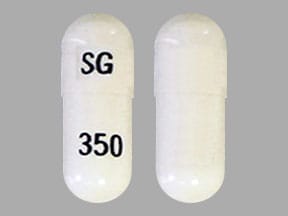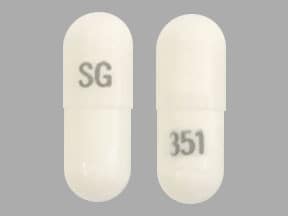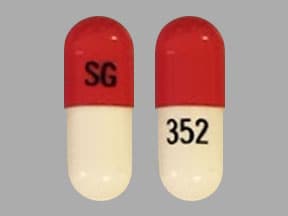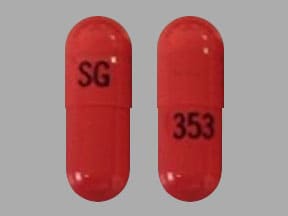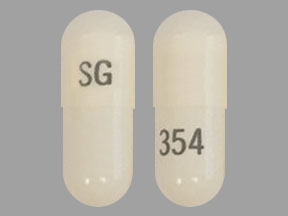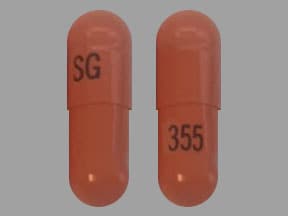Dosage Forms
Excipient information presented when available (limited, particularly for generics); consult specific product labeling.
Capsule, Oral:
Lyrica: 25 mg, 50 mg, 75 mg, 100 mg, 150 mg, 200 mg, 225 mg, 300 mg [contains corn starch]
Generic: 25 mg, 50 mg, 75 mg, 100 mg, 150 mg, 200 mg, 225 mg, 300 mg
Solution, Oral:
Lyrica: 20 mg/mL (473 mL) [contains methylparaben, propylparaben]
Generic: 20 mg/mL (473 mL)
Tablet Extended Release 24 Hour, Oral:
Lyrica CR: 82.5 mg, 165 mg, 330 mg
Pharmacology
Mechanism of Action
Binds to alpha-2-delta subunit of voltage-gated calcium channels within the CNS and modulates calcium influx at the nerve terminals, thereby inhibiting excitatory neurotransmitter release including glutamate, norepinephrine (noradrenaline), serotonin, dopamine, substance P, and calcitonin gene-related peptide (Gajraj 2007; McKeage 2009). Although structurally related to GABA, it does not bind to GABA or benzodiazepine receptors. Exerts antinociceptive and anticonvulsant activity. Pregabalin may also affect descending noradrenergic and serotonergic pain transmission pathways from the brainstem to the spinal cord.
Pharmacokinetics/Pharmacodynamics
Absorption
Extended release: AUC is approximately 30% lower when administered while fasting
Distribution
Vd: 0.5 L/kg
Metabolism
Negligible
Excretion
Urine (90% as unchanged drug; minor metabolites)
Onset of Action
Pain management: Effects may be noted as early as the first week of therapy
Time to Peak
Extended release: Median: 8 hours with food (range: 5 to 12 hours)
Immediate release:
Infants ≥3 months, Children, and Adolescents <17 years: 0.5 to 2 hours fasting
Adults: Within 1.5 hours fasting; ~3 hours with food
Half-Life Elimination
Children ≤6 years: 3 to 4 hours
Children 7 to <17 years: 4 to 6 hours
Adult: 6.3 hours
Protein Binding
0%
Use in Specific Populations
Special Populations: Elderly
Oral clearance tends to decrease with increasing age.
Special Populations: Children
Clearance in pediatric patients weighing <30 kg has been observed to be 40% higher than those weighing ≥30 kg.
Use: Labeled Indications
Fibromyalgia (immediate release only): Management of fibromyalgia
Neuropathic pain associated with diabetic peripheral neuropathy (immediate release and extended release): Management of neuropathic pain associated with diabetic peripheral neuropathy
Neuropathic pain associated with spinal cord injury (immediate release only): Management of neuropathic pain associated with spinal cord injury
Postherpetic neuralgia (immediate release and extended release): Management of postherpetic neuralgia
Seizures, focal (partial) onset (immediate release only): Adjunctive therapy in patients ≥1 month of age with focal onset (partial-onset) seizures
Use: Off Label
Cough, chronic refractoryc
Data from a limited number of patients in a controlled trial suggest that pregabalin in combination with speech pathology therapy may be beneficial for the treatment of refractory chronic cough
Generalized anxiety disorderbyes
Data from several meta-analyses support the use of pregabalin in the treatment of generalized anxiety disorder Baldwin 2011, Boschen 2011, Generoso 2017, Lydiard 2010.
Based on the
Neuropathic pain, critically ill patientsyes
The Society of Critical Care Medicine Clinical Practice Guidelines for the Prevention and Management of Pain, Agitation/Sedation, Delirium, Immobility, and Sleep Disruption in Adult Patients in the ICU suggest pregabalin in combination with opioids is recommended for the management of neuropathic pain in ICU patients SCCM [Devlin 2018].
Postoperative pain (as a component of multimodal analgesia in select patients)b
Data from several meta-analyses support the use of preemptive doses of pregabalin to decrease postoperative pain, opioid use, and nausea and vomiting
Pruritus, neuropathic or malignancy relatedc
Data from a limited number of patients studied suggest that pregabalin may be beneficial for the treatment of chronic neuropathic or malignancy-related pruritus
Pruritus, uremicbyes
Data from several randomized, controlled trials support the use of pregabalin in the treatment of chronic uremic pruritus in dialysis patients Foroutan 2017, Solak 2012, Yue 2015.
Based on the European Dermatology Forum and European Academy of Dermatology and Venerology guidelines on chronic pruritus, pregabalin is recommended in the management of chronic kidney disease-associated pruritus
Restless legs syndromebyes
Data from randomized, double-blind, placebo-controlled studies support the use of pregabalin in the treatment of moderate to severe primary restless legs syndrome (RLS) with predominant evening symptoms Allen 2010, Allen 2014, Garcia-Borreguero 2014.
Based on American Academy of Neurology guidelines and guidelines from the International Restless Legs Syndrome Study Group for the long-term treatment of RLS, pregabalin is effective and recommended in the management of primary RLS Garcia-Borreguero 2013, Winkelman 2016
Based on the
Social anxiety disorderb
Data from 2 double-blind, placebo-controlled, fixed-dose studies and a relapse prevention study support the use of pregabalin in the treatment of social anxiety disorder Feltner 2011, Greist 2011, Pande 2004.
Vasomotor symptoms associated with menopausebyes
Data from a randomized, double-blind, placebo-controlled trial support the use of pregabalin in the treatment of vasomotor symptoms (eg, hot flashes) associated with menopause, including women previously treated for breast cancer Loprinzi 2010.
Based on the
Contraindications
Hypersensitivity (eg, angioedema) to pregabalin or any component of the formulation
Dosage and Administration
Dosing: Adult
Note: When discontinuing, taper off gradually over at least 1 week.
Cough, chronic refractory (alternative agent) (off-label use): Immediate release: Oral: Initial: 75 mg once daily; may increase gradually over the first week in increments of 75 mg/day based on response and tolerability up to a maximum of 300 mg/day in 3 divided doses (eg, 75 mg in morning and midday with 150 mg in the evening) (Vertigan 2016).
Fibromyalgia (alternative agent): Note: For patients who do not respond to or tolerate preferred agents (Goldenberg 2018).
Immediate release: Oral: Initial: 75 mg twice daily; may increase to 150 mg twice daily within 1 week based on response and tolerability; maximum dose: 450 mg/day (manufacturer's labeling). Note: Some experts suggest lower initial doses of 25 to 50 mg at bedtime; some patients may respond to maintenance doses <300 mg/day (Goldenberg 2018).
Generalized anxiety disorder (alternative agent) (off-label use): Note: Monotherapy or adjunctive therapy for patients who do not tolerate or respond to preferred agents (BAP [Baldwin 2014]; Craske 2018).
Immediate release: Oral: Initial: 150 mg/day in 2 to 3 divided doses; may increase based on response and tolerability at weekly intervals in increments of 150 mg/day up to a usual dose of 300 mg/day. May further increase up to 600 mg/day (Kasper 2014; WFSBP [Bandelow 2008]); however, additional benefit of doses >300 mg/day is uncertain (Lydiard 2010). Note: Some experts suggest a lower initial dose of 50 mg/day (Bystritsky 2018).
Neuropathic pain:
General dosing recommendations: Immediate release: Oral: Initial: 25 to 150 mg/day once daily or in 2 divided doses; may increase in increments of 25 to 150 mg/day at intervals ≥1 week based on response and tolerability up to a usual dose of 300 to 600 mg/day in 2 divided doses (CPS [Moulin 2014]; IASP [Finnerup 2015]).
Critically ill ICU patients (off-label use): Oral: Initial: 75 mg once or twice daily in combination with opioids; maintenance dose: 150 to 300 mg twice daily (SCCM [Devlin 2018]; Tietze 2019).
Diabetic neuropathy:
Immediate release: Oral: Initial: 25 to 75 mg/day once daily or in 2 to 3 divided doses; may increase within 1 week based on response and tolerability up to a maximum dose of 300 to 450 mg/day (ADA [Pop-Busui 2017]; Feldman 2018). Higher doses up to 600 mg/day may have greater adverse effects without additional benefit (Arnold 2017).
Extended release: Oral: Initial: 165 mg once daily; may increase within 1 week based on response and tolerability up to maximum dose of 330 mg once daily.
Postherpetic neuralgia:
Immediate release: Oral: Initial: 150 mg/day in divided doses (75 mg twice daily or 50 mg 3 times daily); may increase to 300 mg/day within 1 week based on response and tolerability; after 2 to 4 weeks, may further increase up to the maximum dose of 600 mg/day.
Extended release: Oral: Initial: 165 mg once daily; may increase to 330 mg once daily within 1 week based on response and tolerability; after 2 to 4 weeks, may further increase up to the maximum dose of 660 mg/day.
Spinal cord injury-associated neuropathic pain: Immediate release: Oral: Initial: 75 mg twice daily; may increase within 1 week based on response and tolerability to 150 mg twice daily; after 2 to 3 weeks, may further increase up to a maximum of 600 mg/day.
Postoperative pain (off-label use): Immediate release: Oral: 75 to 300 mg as a single dose, 1 to 2 hours prior to surgery as part of a multimodal analgesia regimen. The use of multiple doses has not been found to provide additional benefit (APS [Chou 2016]; Mishriky 2015).
Pruritus, chronic (alternative agent) (off-label use): Note: For patients with pruritus resistant to preferred therapies (Matsuda 2016; Weisshaar 2012).
Neuropathic (eg, brachioradial pruritus, notalgia paresthetica) or malignancy related: Based on limited data: Immediate release: Oral: Initial: 75 mg twice daily; may increase based on response and tolerability up to 150 to 300 mg/day in 2 to 3 divided doses (Atis 2017; Fazio 2018; Matsuda 2016; Vestita 2016). Higher doses up to 600 mg/day have been used in oncology populations (Dalal 2018).
Uremic: Immediate release: Oral: Variable dosing has been used and includes: 50 mg every other day given after dialysis on hemodialysis days (Foroutan 2017) or 25 mg daily (Kobrin 2018), each increased based on response and tolerability to 50 or 75 mg daily; 75 mg twice weekly given after dialysis on hemodialysis days also appears effective (Yue 2015).
Restless legs syndrome (off-label use): Immediate release: Oral: Initial: 50 to 75 mg once daily, 1 to 3 hours before bedtime; gradually increase (eg, in increments of 75 to 150 mg) every 5 to 7 days based on response and tolerability to a usual effective dose of 150 to 450 mg/day (Allen 2010; Allen 2014; Garcia-Borreguero 2014).
Seizures, focal (partial) onset (adjunctive therapy with other anticonvulsants): Immediate release: Oral: Initial: 150 mg/day in 2 or 3 divided doses; may increase based on response and tolerability at weekly intervals up to a maximum dose of 600 mg/day.
Social anxiety disorder (alternative agent) (off-label use): Note: Monotherapy or adjunctive therapy for patients who do not tolerate or respond to preferred agents (Stein 2018). Immediate release: Oral: Initial: 100 mg 3 times daily; may increase over 1 week in increments of 150 mg/day based on response and tolerability up to 600 mg/day (Feltner 2011; Greist 2011; Pande 2004).
Vasomotor symptoms associated with menopause (alternative agent) (off-label use): Note: Used as a nonhormonal alternative in patients unable or unwilling to take preferred agents (Stuenkel 2015). Some experts prefer gabapentin over pregabalin as an alternative agent because of greater available evidence (Santen 2018).
Immediate release: Oral: Initial: 50 mg once daily at bedtime; may increase at weekly intervals based on response and tolerability to 50 mg twice daily, and then up to 75 mg twice daily; may further increase up to 150 mg twice daily (Loprinzi 2010).
Dosing conversion from immediate-release oral formulations to extended-release oral formulation: Note: On the day of the switch, administer morning dose of immediate-release product as prescribed, and initiate extended-release therapy after the evening meal.
Immediate-release total daily dose of 75 mg is equivalent to extended-release dose of 82.5 mg once daily
Immediate-release total daily dose of 150 mg is equivalent to extended-release dose of 165 mg once daily
Immediate-release total daily dose of 225 mg is equivalent to extended-release dose of 247.5 mg once daily
Immediate-release total daily dose of 300 mg is equivalent to extended-release dose of 330 mg once daily
Immediate-release total daily dose of 450 mg is equivalent to extended-release dose of 495 mg once daily
Immediate-release total daily dose of 600 mg is equivalent to extended-release dose of 660 mg once daily
Discontinuation of therapy: In patients receiving pregabalin chronically, unless safety concerns require a more rapid withdrawal, pregabalin should be withdrawn gradually over ≥1 week to minimize the potential of increased seizure frequency (in patients with epilepsy) or other withdrawal symptoms (eg, agitation, confusion, delirium, delusions, GI symptoms, mood changes, sweating, withdrawal seizures) (Bonnet 2017; "Gabapentin and Pregabalin" 2012).
Dosing: Geriatric
Refer to adult dosing; use with caution. In the management of restless legs syndrome, a starting dose of 50 mg once daily in patients >65 years has been recommended (Garcia-Borreguero 2016).
Dosing: Pediatric
Note: When discontinuing, taper off gradually over at least 1 week.
Seizures, partial onset; adjunctive therapy: Immediate release:
Infants and Children <4 years weighing <30 kg: Oral: Initial dose: 3.5 mg/kg/day in 3 divided doses; dose may be increased weekly based on clinical response and tolerability; maximum daily dose: 14 mg/kg/day.
Children ≥4 years and Adolescents <17 years:
<30 kg: Oral: Initial dose: 3.5 mg/kg/day in 2 or 3 divided doses; dose may be increased weekly based on clinical response and tolerability; maximum daily dose: 14 mg/kg/day.
≥30 kg: Oral: Initial dose: 2.5 mg/kg/day in 2 or 3 divided doses; dose may be increased weekly based on clinical response and tolerability; maximum daily dose: 10 mg/kg/day not to exceed 600 mg/day.
Adolescents ≥17 years: Oral: Initial dose: 150 mg daily in 2 or 3 divided doses; may be increased weekly based on tolerability and effect; maximum daily dose: 600 mg/day.
Fibromyalgia: Limited data available: Immediate release: Children ≥12 years and Adolescents: Oral: Initial: 37.5 mg twice daily for 1 week, then titrate based on clinical response and tolerability to 150 to 450 mg/day in 2 divided doses; maximum daily dose: 450 mg/day. Dosing based on a multi-center, double-blind, placebo-controlled trial (15 weeks) and secondary open-label continuation trial (6 months) (n=107; pregabalin n=54; age range: 12 to 17 years); total daily doses were titrated weekly to an individually optimized dose of 150 mg/day, 300 mg/day, or 450 mg/day; maximum daily dose: 450 mg/day; mean dose during maintenance phase of double-blind study was 244.5 mg/day and in the open label trial it was 254.3 mg/day. Although the primary endpoint of change in mean pain scores from baseline to week 15 was not statistically significant, there was a trend toward improvement in the pregabalin group. Change in weekly mean pain scores was significantly greater with pregabalin compared to placebo for 10 of the 15 weeks; the patient global impression of change was also significantly improved in patients receiving pregabalin (53.1%) compared to placebo (29.5%). The authors reported a large placebo effect, particularly at non-US study centers; however, significance of this is unknown (Arnold 2016).
Administration
Immediate release: May be administered with or without food.
Extended release: Administer once daily after an evening meal; swallow whole, do not split, crush, or chew. A missed dose should be taken before bedtime following a snack. If missed before bedtime, administer in the morning with a meal. If missed in the morning, wait until the evening meal to take the next scheduled dose.
Storage
Store at 20°C to 25°C (68°F to 77°F); excursions permitted to 15°C to 30°C (59°F to 86°F).
Pregabalin Images
Drug Interactions
Alcohol (Ethyl): CNS Depressants may enhance the CNS depressant effect of Alcohol (Ethyl). Monitor therapy
Alizapride: May enhance the CNS depressant effect of CNS Depressants. Monitor therapy
Angiotensin-Converting Enzyme Inhibitors: May enhance the adverse/toxic effect of Pregabalin. Specifically, the risk of angioedema may be increased. Monitor therapy
Azelastine (Nasal): CNS Depressants may enhance the CNS depressant effect of Azelastine (Nasal). Avoid combination
Blonanserin: CNS Depressants may enhance the CNS depressant effect of Blonanserin. Consider therapy modification
Brexanolone: CNS Depressants may enhance the CNS depressant effect of Brexanolone. Monitor therapy
Brimonidine (Topical): May enhance the CNS depressant effect of CNS Depressants. Monitor therapy
Bromopride: May enhance the CNS depressant effect of CNS Depressants. Monitor therapy
Bromperidol: May enhance the CNS depressant effect of CNS Depressants. Avoid combination
Buprenorphine: CNS Depressants may enhance the CNS depressant effect of Buprenorphine. Management: Consider reduced doses of other CNS depressants, and avoiding such drugs in patients at high risk of buprenorphine overuse/self-injection. Initiate buprenorphine at lower doses in patients already receiving CNS depressants. Consider therapy modification
Cannabidiol: May enhance the CNS depressant effect of CNS Depressants. Monitor therapy
Cannabis: May enhance the CNS depressant effect of CNS Depressants. Monitor therapy
Chlormethiazole: May enhance the CNS depressant effect of CNS Depressants. Management: Monitor closely for evidence of excessive CNS depression. The chlormethiazole labeling states that an appropriately reduced dose should be used if such a combination must be used. Consider therapy modification
Chlorphenesin Carbamate: May enhance the adverse/toxic effect of CNS Depressants. Monitor therapy
CNS Depressants: May enhance the adverse/toxic effect of other CNS Depressants. Monitor therapy
Dimethindene (Topical): May enhance the CNS depressant effect of CNS Depressants. Monitor therapy
Doxylamine: May enhance the CNS depressant effect of CNS Depressants. Management: The manufacturer of Diclegis (doxylamine/pyridoxine), intended for use in pregnancy, specifically states that use with other CNS depressants is not recommended. Monitor therapy
Dronabinol: May enhance the CNS depressant effect of CNS Depressants. Monitor therapy
Droperidol: May enhance the CNS depressant effect of CNS Depressants. Management: Consider dose reductions of droperidol or of other CNS agents (eg, opioids, barbiturates) with concomitant use. Exceptions to this monograph are discussed in further detail in separate drug interaction monographs. Consider therapy modification
Esketamine: May enhance the CNS depressant effect of CNS Depressants. Monitor therapy
Flunitrazepam: CNS Depressants may enhance the CNS depressant effect of Flunitrazepam. Consider therapy modification
HYDROcodone: CNS Depressants may enhance the CNS depressant effect of HYDROcodone. Management: Avoid concomitant use of hydrocodone and benzodiazepines or other CNS depressants when possible. These agents should only be combined if alternative treatment options are inadequate. If combined, limit the dosages and duration of each drug. Consider therapy modification
HydrOXYzine: May enhance the CNS depressant effect of CNS Depressants. Monitor therapy
Kava Kava: May enhance the adverse/toxic effect of CNS Depressants. Monitor therapy
Lemborexant: May enhance the CNS depressant effect of CNS Depressants. Management: Dosage adjustments of lemborexant and of concomitant CNS depressants may be necessary when administered together because of potentially additive CNS depressant effects. Close monitoring for CNS depressant effects is necessary. Consider therapy modification
Lofexidine: May enhance the CNS depressant effect of CNS Depressants. Management: Drugs listed as exceptions to this monograph are discussed in further detail in separate drug interaction monographs. Monitor therapy
Magnesium Sulfate: May enhance the CNS depressant effect of CNS Depressants. Monitor therapy
Mefloquine: May diminish the therapeutic effect of Anticonvulsants. Mefloquine may decrease the serum concentration of Anticonvulsants. Management: Mefloquine is contraindicated for malaria prophylaxis in persons with a history of convulsions. Monitor anticonvulsant concentrations and treatment response closely with concurrent use. Consider therapy modification
Methotrimeprazine: CNS Depressants may enhance the CNS depressant effect of Methotrimeprazine. Methotrimeprazine may enhance the CNS depressant effect of CNS Depressants. Management: Reduce adult dose of CNS depressant agents by 50% with initiation of concomitant methotrimeprazine therapy. Further CNS depressant dosage adjustments should be initiated only after clinically effective methotrimeprazine dose is established. Consider therapy modification
MetyroSINE: CNS Depressants may enhance the sedative effect of MetyroSINE. Monitor therapy
Mianserin: May diminish the therapeutic effect of Anticonvulsants. Monitor therapy
Minocycline (Systemic): May enhance the CNS depressant effect of CNS Depressants. Monitor therapy
Nabilone: May enhance the CNS depressant effect of CNS Depressants. Monitor therapy
Opioid Agonists: CNS Depressants may enhance the CNS depressant effect of Opioid Agonists. Management: Avoid concomitant use of opioid agonists and benzodiazepines or other CNS depressants when possible. These agents should only be combined if alternative treatment options are inadequate. If combined, limit the dosages and duration of each drug. Consider therapy modification
Orlistat: May decrease the serum concentration of Anticonvulsants. Monitor therapy
Orphenadrine: CNS Depressants may enhance the CNS depressant effect of Orphenadrine. Avoid combination
Oxomemazine: May enhance the CNS depressant effect of CNS Depressants. Avoid combination
OxyCODONE: CNS Depressants may enhance the CNS depressant effect of OxyCODONE. Management: Avoid concomitant use of oxycodone and benzodiazepines or other CNS depressants when possible. These agents should only be combined if alternative treatment options are inadequate. If combined, limit the dosages and duration of each drug. Consider therapy modification
Paraldehyde: CNS Depressants may enhance the CNS depressant effect of Paraldehyde. Avoid combination
Perampanel: May enhance the CNS depressant effect of CNS Depressants. Management: Patients taking perampanel with any other drug that has CNS depressant activities should avoid complex and high-risk activities, particularly those such as driving that require alertness and coordination, until they have experience using the combination. Consider therapy modification
Piribedil: CNS Depressants may enhance the CNS depressant effect of Piribedil. Monitor therapy
Pramipexole: CNS Depressants may enhance the sedative effect of Pramipexole. Monitor therapy
ROPINIRole: CNS Depressants may enhance the sedative effect of ROPINIRole. Monitor therapy
Rotigotine: CNS Depressants may enhance the sedative effect of Rotigotine. Monitor therapy
Rufinamide: May enhance the adverse/toxic effect of CNS Depressants. Specifically, sleepiness and dizziness may be enhanced. Monitor therapy
Selective Serotonin Reuptake Inhibitors: CNS Depressants may enhance the adverse/toxic effect of Selective Serotonin Reuptake Inhibitors. Specifically, the risk of psychomotor impairment may be enhanced. Monitor therapy
Sodium Oxybate: May enhance the CNS depressant effect of CNS Depressants. Management: Consider alternatives to combined use. When combined use is needed, consider minimizing doses of one or more drugs. Use of sodium oxybate with alcohol or sedative hypnotics is contraindicated. Consider therapy modification
Suvorexant: CNS Depressants may enhance the CNS depressant effect of Suvorexant. Management: Dose reduction of suvorexant and/or any other CNS depressant may be necessary. Use of suvorexant with alcohol is not recommended, and the use of suvorexant with any other drug to treat insomnia is not recommended. Consider therapy modification
Tapentadol: May enhance the CNS depressant effect of CNS Depressants. Management: Avoid concomitant use of tapentadol and benzodiazepines or other CNS depressants when possible. These agents should only be combined if alternative treatment options are inadequate. If combined, limit the dosages and duration of each drug. Consider therapy modification
Tetrahydrocannabinol: May enhance the CNS depressant effect of CNS Depressants. Monitor therapy
Tetrahydrocannabinol and Cannabidiol: May enhance the CNS depressant effect of CNS Depressants. Monitor therapy
Thalidomide: CNS Depressants may enhance the CNS depressant effect of Thalidomide. Avoid combination
Thiazolidinediones: Pregabalin may enhance the fluid-retaining effect of Thiazolidinediones. Monitor therapy
Trimeprazine: May enhance the CNS depressant effect of CNS Depressants. Monitor therapy
Zolpidem: CNS Depressants may enhance the CNS depressant effect of Zolpidem. Management: Reduce the Intermezzo brand sublingual zolpidem adult dose to 1.75 mg for men who are also receiving other CNS depressants. No such dose change is recommended for women. Avoid use with other CNS depressants at bedtime; avoid use with alcohol. Consider therapy modification
Adverse Reactions
As reported with adult patients, unless otherwise noted.
>10%:
Cardiovascular: Peripheral edema (4% to 16%)
Central nervous system: Dizziness (3% to 45%), drowsiness (≤36%; infants, children, and adolescents: 13% to 26%), headache (2% to 14%), fatigue (4% to 11%)
Endocrine & metabolic: Weight gain (2% to 14%)
Gastrointestinal: Xerostomia (≤15%)
Ophthalmic: Visual field loss (13%), blurred vision (≤12%)
1% to 10%:
Cardiovascular: Edema (≤8%), facial edema (1% to 3%), chest pain (2%), hypertension (2%), hypotension (2%)
Central nervous system: Ataxia (2% to 9%), balance impairment (2% to 9%), abnormal gait (1% to 8%), euphoria (2% to 7%), confusion (1% to 7%), disturbance in attention (4% to 6%), abnormality in thinking (1% to 6%), neuropathy (5%), pain (3% to 5%), myasthenia (1% to 5%), insomnia (4%), amnesia (1% to 4%), memory impairment (1% to 4%), vertigo (1% to 4%), hypoesthesia (2% to 3%), feeling abnormal (1% to 3%), speech disturbance (1% to 3%), anxiety (2%), paresthesia (2%), disorientation (1% to 2%), intoxicated feeling (1% to 2%), lethargy (1% to 2%), anorgasmia (≥1%), depersonalization (≥1%), hypertonia (≥1%), sedated state (≥1%), stupor (≥1%), twitching (≥1%; includes myokymia), nervousness (1%)
Dermatologic: Pressure ulcer (3%), ecchymoses (≥1%), pruritus (≥1%), contact dermatitis (1%)
Endocrine & metabolic: Fluid retention (2% to 3%), hypoglycemia (2% to 3%), decreased libido (≥1%)
Gastrointestinal: Constipation (3% to 10%), increased appetite (3% to 10%), nausea (3% to 5%), sialorrhea (children and adolescents: 1% to 4%), flatulence (2% to 3%), vomiting (1% to 3%), abdominal distension (2%), abdominal pain (≥1%), gastroenteritis (≥1%), diarrhea (1%), viral gastroenteritis (≤1%)
Genitourinary: Urinary incontinence (1% to 3%), impotence (≥1%), urinary frequency (≥1%), erectile dysfunction (≤1%), urinary tract infection (1%)
Hematologic & oncologic: Thrombocytopenia (3%)
Hepatic: Increased serum alanine aminotransferase (≤1%), increased serum aspartate aminotransferase (≤1%)
Hypersensitivity: Hypersensitivity reaction (≥1%)
Infection: Infection (6% to 8%), viral infection (infants and children: 6%)
Neuromuscular & skeletal: Asthenia (4% to 7%), arthralgia (1% to 6%), muscle spasm (4%), back pain (1% to 4%), limb pain (3%), neck pain (3%), increased creatine phosphokinase in blood specimen (2% to 3%), tremor (1% to 3%), joint swelling (≤2%), lower limb cramp (≥1%), myalgia (≥1%)
Ophthalmic: Decreased visual acuity (7%), visual disturbance (1% to 5%), diplopia (≤4%), eye disease (1% to 2%), conjunctivitis (≥1%), nystagmus disorder (≥1%)
Otic: Otitis media (≥1%), tinnitus (≥1%)
Respiratory: Pneumonia (infants and children: 1% to 9%; adults: <1%), nasopharyngitis (1% to 8%), sinusitis (≤7%), bronchitis (3%), pharyngolaryngeal pain (3%), dyspnea (2%), flu-like symptoms (2%), cough (1%), respiratory tract infection (1%)
Miscellaneous: Accidental injury (3% to 6%), fever (≥1%)
Frequency not defined: Cardiovascular: Prolongation P-R interval on ECG
<1%, postmarketing, and/or case reports: Abnormal dreams, abscess, accommodation disturbance, acute renal failure, ageusia, agitation, albuminuria, alopecia, altered sense of smell, amenorrhea, anemia, angioedema, anisocoria, apathy, aphasia, aphthous stomatitis, apnea, arthropathy, ascites, atelectasis, balanitis, bladder neoplasm, blepharitis, blepharoptosis, blindness, bradykinesia, breast hypertrophy, bronchiolitis, cardiac failure, cellulitis, cerebellar syndrome, cervicitis, chills, cholecystitis, cholelithiasis, chondrodystrophy, cognitive dysfunction, cogwheel rigidity, colitis, coma, corneal ulcer, cutaneous nodule, decreased glucose tolerance, delirium, delusions, depression of ST segment on ECG, dermal ulcer, drug dependence, dry mucous membranes, dysarthria, dysautonomia, dysgeusia, dyskinesia, dysmenorrhea, dyspareunia, dysphagia, dystonia, dysuria, eczema, ejaculatory disorder, encephalopathy, eosinophilia, epididymitis, erythema of skin, esophageal ulcer, esophagitis, exfoliative dermatitis, exophthalmos, extraocular palsy, extrapyramidal reaction, facial pain, gastritis, gastrointestinal hemorrhage, glomerulonephritis, glycosuria, granuloma, Guillain-Barre syndrome, gynecomastia, hallucination, hangover effect, heavy menstrual bleeding, hematuria, hemophthalmos, hiccups, hirsutism, hostility, hypalgesia, hyperacusis, hyperalgesia, hyperesthesia, hyperkinetic muscle activity, hypochromic anemia, hypokinesia, hypoprothrombinemia, hypotonia, impaired consciousness, increased libido, increased neutrophils, increased serum lipase, intracranial hypertension, iritis, irritability, joint stiffness, keratitis, keratoconjunctivitis, lactation (females), laryngismus, leukocytosis, leukopenia, leukorrhea, lichenoid dermatitis, local inflammation (coccydynia), lymphadenopathy, malaise, manic reaction, melanosis, melena, miosis, mydriasis, myelofibrosis, myoclonus, nail disease, neck stiffness, nephritis, nephrolithiasis, neuralgia, nocturnal amblyopia, nonimmune anaphylaxis, nonthrombocytopenic purpura, oliguria, ophthalmoplegia, optic atrophy, oral mucosa ulcer, oral paresthesia, orthostatic hypotension, ovarian disease, palpitations, pancreatitis, papilledema, paranoid ideation, pelvic pain, periodontal abscess, periorbital edema, peripheral neuritis, personality disorder, petechial rash, photophobia, polycythemia, proteinuria, psychomotor disturbance, psychotic depression, pulmonary edema, pulmonary fibrosis, purpuric rash, pustular rash, pyelonephritis, rectal hemorrhage, respiratory depression (FDA Safety Alert, Dec 19, 2019), retinal edema, retinal vascular disease, retroperitoneal fibrosis, rhabdomyolysis, sciatica, schizophrenia, self-inflicted intentional injury, severe thrombocytopenia, shock, skin atrophy, skin blister, skin necrosis, skin photosensitivity, skin rash, sleep disorder, Stevens-Johnson syndrome, subcutaneous nodule, syncope, tachycardia, thrombocythemia, thrombophlebitis, tongue edema, torticollis, trismus, urate crystalluria, urinary retention, urine abnormality, urticaria, uterine hemorrhage, uveitis, ventricular fibrillation, vesiculobullous dermatitis, wheezing, xeroderma, xerophthalmia, yawning
Warnings/Precautions
Concerns related to adverse effects:
- Angioedema: Angioedema has been reported during initial and chronic treatment; may be life-threatening. Symptoms reported include facial, mouth (tongue, lips, and gums), and neck (throat and larynx) swelling. Use with caution in patients with a history of angioedema episodes. Concurrent use with other drugs known to cause angioedema (eg, ACE inhibitors) may increase risk. Discontinue treatment immediately if angioedema occurs.
- CNS effects: Dizziness and somnolence are commonly reported; effects generally occur shortly after initiation and occur more frequently at higher doses. Patients must be cautioned about performing tasks which require mental alertness (eg, operating machinery or driving).
- Hematologic effects: May decrease platelet count. Severe thrombocytopenia is extremely rare.
- Hypersensitivity: Hypersensitivity reactions, including skin redness, blistering, hives, rash, dyspnea, and wheezing have been reported shortly after initiation of treatment; discontinue treatment if hypersensitivity occurs.
- Peripheral edema: Use may cause peripheral edema; use with caution in patients with heart failure (NYHA Class III or IV) due to limited data in this patient population. In addition, effect on weight gain/edema may be additive with the thiazolidinedione class of antidiabetic agents; use caution when coadministering these agents, particularly in patients with prior cardiovascular disease.
- PR interval: May cause mild prolongation of PR interval. Clinical significance unknown.
- Rhabdomyolysis: Has been associated with increases in creatine kinase and rare cases of rhabdomyolysis; patients should be instructed to notify their prescriber if unexplained muscle pain, tenderness, or weakness, particularly if fever and/or malaise are associated with these symptoms. Discontinue treatment if myopathy is suspected or diagnosed or if markedly elevated creatine kinase levels occur.
- Suicidal ideation: Pooled analysis of trials involving various antiepileptics (regardless of indication) showed an increased risk of suicidal thoughts/behavior (incidence rate: 0.43% treated patients compared to 0.24% of patients receiving placebo); risk observed as early as 1 week after initiation and continued through duration of trials (most trials ≤24 weeks). Monitor all patients for notable changes in behavior that might indicate suicidal thoughts or depression; notify healthcare provider immediately if symptoms occur.
- Visual disturbances: Blurred vision, decreased acuity and visual field changes have been associated with therapy; patients should be instructed to notify their physician if these effects are noted.
- Weight gain: Use may cause weight gain; weight gain generally associated with dose and duration (average weight gain was 5.2 kg for diabetic patients receiving pregabalin for ≥2 years); weight gain was not limited to patients with edema and did not appear to be associated with baseline BMI, gender, age, or loss of glycemic control in diabetic patients.
Disease-related concerns:
- Cardiovascular disease: Use with caution in patients with severe cardiovascular disease, including heart failure; weight gain and/or peripheral edema may occur. In a scientific statement from the American Heart Association, pregabalin has been determined to be an agent that may exacerbate underlying myocardial dysfunction (magnitude: minor to moderate) (AHA [Page 2016]).
- Renal impairment: Use with caution in patients with renal impairment; dosage adjustment required.
- Substance abuse: Use with caution in patients with a history of substance abuse; potential for behavioral dependence in this population exists (Bonnet 2017).
Concurrent drug therapy issues:
- Drug-drug interactions: Potentially significant interactions may exist, requiring dose or frequency adjustment, additional monitoring, and/or selection of alternative therapy. Consult drug interactions database for more detailed information.
Other warnings/precautions:
- Tumorigenic potential: Increased incidence of hemangiosarcoma noted in animal studies; significance of these findings in humans is unknown.
- Withdrawal: Anticonvulsants should not be discontinued abruptly because of the possibility of increasing seizure frequency; therapy should be withdrawn gradually unless safety concerns require a more rapid withdrawal. Tapering over at least 1 week is recommended. Abrupt discontinuation with pregabalin has been associated with anxiety, diarrhea, headache, hyperhidrosis, insomnia, and nausea.
Monitoring Parameters
Measures of efficacy (pain intensity/seizure frequency); degree of sedation; symptoms of myopathy; creatine kinase (as clinically indicated); symptoms of ocular disturbance; weight gain/edema; skin integrity (in patients with diabetes); signs and symptoms of suicidality (eg, suicidal thoughts, anxiety, depression, behavioral changes); platelet count (as clinically indicated)
Pregnancy
Pregnancy Considerations
Pregabalin crosses the placenta (Ohman 2011). Studies which evaluated neonatal outcomes following pregabalin exposure during pregnancy are limited (Mostacci 2017; Patorno 2017; Veiby 2014; Winterfeld 2016). Pregabalin has been evaluated as an adjuvant pain medication following cesarean section and pregnancy termination (El Kenany 2016; Lavand'homme 2010).
In a study conducted in males, pregabalin was found to temporarily decrease mean sperm concentrations; no effects on sperm morphology or motility were observed. Concentrations increased after pregabalin was discontinued. The clinical relevance of this is not known.
Data collection to monitor pregnancy and infant outcomes following exposure to pregabalin is ongoing. Patients exposed to pregabalin during pregnancy are encouraged to enroll themselves into the North American Antiepileptic Drug (NAAED) Pregnancy Registry by calling 1-888-233-2334. Additional information is available at www.aedpregnancyregistry.org.
Patient Education
What is this drug used for?
- It is used to help control certain kinds of seizures, to treat painful nerve diseases, and to treat fibromyalgia. It may be given to you for other reasons. Talk with the doctor.
Frequently reported side effects of this drug
- Nose irritation
- Throat irritation
- Trouble focusing
- Headache
- Dry mouth
- Loss of strength and energy
- Constipation
- Lack of appetite
- Joint pain
- Nausea
Other side effects of this drug: Talk with your doctor right away if you have any of these signs of:
- Swelling in your throat
- Depression like thoughts of suicide, anxiety, agitation, irritability, panic attacks, mood changes, behavioral changes, or confusion
- Vision changes
- Muscle pain
- Muscle weakness
- Seizures
- Bruising
- Bleeding
- Change in balance
- Confusion
- Tremors
- Trouble breathing
- Slow breathing
- Shallow breathing
- Blue/gray skin discoloration
- Trouble with memory
- Shortness of breath
- Excessive weight gain
- Swelling of arms or legs
- Fast heartbeat
- Abnormal heartbeat
- Chills
- Sore throat
- Skin sores
- Trouble speaking
- Trouble sleeping
- Abnormal gait
- Feeling high
- Twitching
- Severe fatigue
- Severe dizziness
- Passing out
- Signs of a significant reaction like wheezing; chest tightness; fever; itching; bad cough; blue skin color; seizures; or swelling of face, lips, tongue, or throat.
Note: This is not a comprehensive list of all side effects. Talk to your doctor if you have questions.
Consumer Information Use and Disclaimer: This information should not be used to decide whether or not to take this medicine or any other medicine. Only the healthcare provider has the knowledge and training to decide which medicines are right for a specific patient. This information does not endorse any medicine as safe, effective, or approved for treating any patient or health condition. This is only a brief summary of general information about this medicine. It does NOT include all information about the possible uses, directions, warnings, precautions, interactions, adverse effects, or risks that may apply to this medicine. This information is not specific medical advice and does not replace information you receive from the healthcare provider. You must talk with the healthcare provider for complete information about the risks and benefits of using this medicine.
